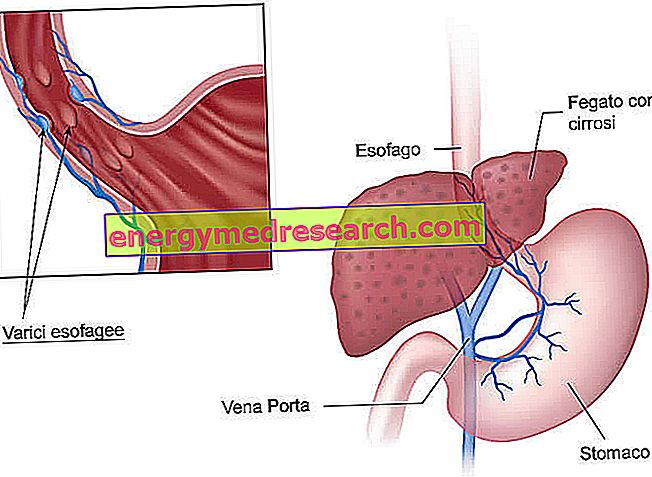Generality
Esophageal varices are abnormal dilatations, circumscribed and usually multiple, of the submucosal veins of the esophagus, in particular of its lower third. A typical consequence of portal hypertension, esophageal varices have a congenital origin only in a small percentage of cases; more often, they are known to embody one of the most feared complications of liver cirrhosis; if not treated properly, in fact, esophageal varices can break, resulting in very serious bleeding, lethal in one out of five patients.

Causes
The understanding of the pathogenesis of esophageal varices cannot ignore the in-depth knowledge of the anatomy of the venous system of the organism. By simplifying the concepts to the maximum we recall how the portal vein has the task of conveying to the liver the blood coming from the spleen, pancreas and intestine. When the blood circulation of the liver is compromised and the blood struggles to flow in and out of it - pouring into the hepatic veins (whose task is to bring it back to the heart through the inferior vena cava) - the pressure inside the portal vein increases. In this case, we speak of portal hypertension. If we imagine a rubber hose to water and compare it to the portal vein, then in the presence of portal hypertension we have to think of a cap that prevents the water from leaking from the tube: if we do not close the tap in time, the water pressure in the tube will whiten the walls until it explodes.
The most common causes of esophageal varices:
- Cirrhosis (scarring of the liver)
- Congenital intrahepatic scarring or obstructive processes
- Thrombosis (presence of clots that obstruct the portal vein, the splenic vein or the hepatic veins)
- Schistosomiasis (parasitic infection typical of tropical countries)
- In Italy, over 90% of portal hypertensions are due to liver cirrhosis
Fortunately, nature has equipped the human body with defensive mechanisms to avoid the tragic rupture of its vessels; once again we must use the imagination to compare the circulatory system to an intricate network of vessels, similar to the disordered mesh of a net: if the outflow of blood along a vessel is obstructed or excessively increases the amount of blood there is circulates, there are side streets that can bypass the obstacle. Thus, in the presence of portal hypertension the bursting of the vein is averted by the hijacking of the blood in other venous branches, which guarantee its return to the heart. To fulfill this function the collateral circles try in some way to adapt to accommodate the greater quantity of blood that pervades them. In particular, at the level of the gastroesophageal junction, the submucosal veins become swollen until they become true varicose dilatations: the esophageal varices. A similar situation occurs in the haemorrhoidal district, with the formation of anorectal varices, better known as hemorrhoids.
Symptoms
To learn more: Esophageal Varic Symptoms
The esophageal varices manifest themselves with difficulty in swallowing (dysphagia), but the most characteristic and dangerous sign is represented by the bleeding, signaled by the emission of blood through vomit (hematemesis) or through the feces (melena: the blood, being digested, it has a tarry consistency). It is assumed that the rupture of the esophageal varices is the consequence of the rise of gastric juices along the esophagus (regurgitation or reflux), whose acidity erodes the esophageal mucosa.
To the typical symptoms of the varicose veins of the esophagus are added those of the underlying disease, for example those deriving from cirrhosis (jaundice, vomiting, liver tenderness, edema, splenomegaly, ascites).
Diagnosis and Treatment
To learn more: Drugs for the treatment of Esophageal Varices
The endoscopic examination by esophagus-gastro-duodenoscopy allows to observe the appearance of the varicose veins, important for their classification and the assessment of the risk of rupture. This examination is generally prescribed to patients who have unexplained bleeding from the upper part of the digestive tract.
Depending on the appearance of the esophageal varices and the patient's general state of health, the doctor may prescribe non-cardioselective beta blockers such as propranolol and nadolol to contain portal hypertension.
Nitroderivatives are also used for this purpose.
If the risk of bleeding of the esophageal varices is important, always through esophagus-gastro-duodenoscopy (operative) the doctor proceeds to the ligation of the same, "strangling them" through rubber rings that choke the veins, closing them and making them gradually disappear.
An alternative to ligation is the sclerosis of the same, which occurs by the injection of substances capable of inducing the formation of clots inside the varicose veins. To completely close all the dilated veins, more treatments may be necessary; the operation will then be repeated every 2-3 weeks until the disappearance of the esophageal varices.
An alternative to these treatments consists in the decompression of the portal system by porto-systemic shunts: in practice, artificial venous bridges are inserted that drain the blood from the portal vein to the vena cava bypassing the liver.



